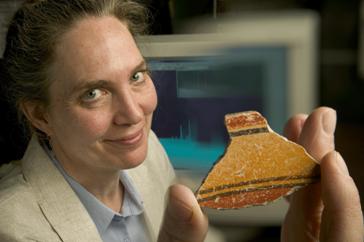|
Archaeometry at OSU’s Radiation Center |
|
Trace-element analyses for research and conservation. |


|
Dr. Leah Minc |
|
Ph.D. Anthropology, University of Michigan 1994
M.A. Anthropology, University of Chicago 1982
A.B. Archaeology, Douglass College 1977 |
|
Compositional analyses of archaeological materials play a significant role in the investigation of past human behavior and ancient economies. Through trace-element characterization of artifacts, raw materials, human remains, and botanical samples, archaeologists are able to address a host of questions concerning resource utilization, trade and exchange, subsistence practices, and the environmental adaptations of past cultures.
At OSU, we’re fortunate to have ready access to the premier method of trace-element characterization - Instrumental Neutron Activation Analysis (INAA). I head the INAA program at the Radiation Center (OSU-RC) and serve as liaison to researchers using irradiation facilities and detector instrumentation. I also have an active research program in archaeometry and compositional analysis, through collaboration with faculty researchers at OSU and other academic institutions. Recent and on-going projects include analyses of Colonial-era bricks from Maryland, Aztec ceramics from central Mexico, chert from Idaho, and obsidian from Armenia. |
|
Archaeometry (Materials Science in Archaeology) |
|
Political Economy and Exchange in Early Complex Societies |
|
One key application of trace-element data is in monitoring how raw materials and finished goods circulated in prehistory. Archaeologists can “source” artifacts from their trace-element signature or fingerprint. Once finished artifacts have been linked in their geographic point of origin, mechanisms of trade and exchange, political geography, and social controls over the circulation of goods can be modeled based on the distribution of artifacts from that source.
I am particularly interested in the development of market exchange systems, and the role of elites in regulating market exchange in early states. Although we tend to characterize market exchange as a purely commercial activity, elites frequently intervened in the “commercial sector” to promote their own agenda. Research on market exchange is on-going in three areas: the core of the Aztec empire, the early Zapotec state in central Oaxaca, and the Bronze Age states of Armenia. In each case, key questions include: What mechanisms existed to regulate access to and control over the flow of goods? And, how did these controls affect the decisions of individual producers and consumers? |
|
in Neutron Activation Analysis (NAA). Encyclopedia of Archaeology, Elsevier Major Reference press Works, Oxford (accepted for publication December, 2006).
in Style and Substance: Evidence for Regionalization within the Aztec Market System. press Latin American Antiquity (accepted for publication January, 2006).
in "M Glow Blue": Archaeometric Research at Michigan's Ford Nuclear Reactor, with J.R. press Sherman, C. Elson, C.S. Spencer, and E. M. Redmond. Special issue of Archaeometry (due out 2007).
2007 Fowles, S., L.D. Minc, S. Duwe, and D. Hill. Clay, Conflict, and Village Aggregation: Compositional Analyses of Pre-classic Pottery from Taos, New Mexico. American Antiquity: 72(1): 125-152.
2006 Minc, L.D., Monitoring Regional Market Systems in Prehistory: Models, Methods, and Metrics. Journal of Anthropological Archaeology 25(1):82-116.
2006 Armitage, R.A., L.D. Minc, D.V. Hill, and S. D. Hurry, Characterization of Bricks and Tiles from the 17th-century Brick Chapel, St. Mary's City, Maryland. Journal of Archaeological Science 33(5):615-627.
2006 Alden, J. R., L.D. Minc, and T.F. Lynch. Identifying the sources of Inka period ceramics from northern Chile: results of a neutron activation study. Journal of Archaeological Science 33(4):575-594.
2005 Bray, T.L., L.D. Minc, M. Constanza-Ceruti, R. Perea, J. Reinhard, and J. Chávez) A Compositional Analysis of Pottery Vessels Associated with the Inca Ritual of Capacocha. Journal of Anthropological Archaeology 24(1):82-100.
2004 Elson, C., R. J. Sherman, L.D. Minc, C.S. Spencer, E.M. Redmond. Los Resultados Preliminares de Instrumental Neutron Activation Analysis (INAA) de la cerámica de las fases Monte Albán I y Monte Albán II de los sitios de El Palenque, Cerro Tilcajete y Yaasuchi. In Cuarta Mesa Redonda de Monte Albán, edited by N. R. G. y R. Spores. Instituto Nacional de Antropología e Historia, México.
2003 Smith, A. T., R. Badalyan, P. Avetisyan, M. Zardarian, A. Hayrepetyan, L. Minc, and B. Monahan. Early Complex Societies in Southern Transcaucasia: a Preliminary Report on the 2002 Investigations of Project ARAGATS on the Tsakahovit Plain, Republic of Armenia. American Journal of Archaeology 108(1): 1-41.
2002 Michelaki, K., L. Minc, and J. O’Shea. Integrating Typology and Physico-Chemical Approaches to Examine the Potter's Choices: a Case Study from Bronze Age Hungary, In Modern Trends in Scientific Studies on Ancient Ceramics, ed. by Y. Maniatis and V. Kilikoglou, pp. 313-322, British Archaeological Reports International Series 1011.
1994 Minc, L..D., M. G. Hodge, and M. J. Blackman. Stylistic and Spatial Variability in Early Aztec Ceramics: Insights into Pre-Imperial Exchange Systems. In Economies and Polities in the Aztec Realm, edited by M. G. Hodge and M. E. Smith, pp. 133-173. IMS Studies on Culture and Society Series No. 5. Institute for Meso-american Studies, State University of New York, Albany.
1993 Hodge, M.G., H. Neff, M.J. Blackman, and L. D. Minc. The Regional Structure of Black-on- Orange Ceramic Production in the Aztec Empire's Heartland. Latin American Antiquity 4(2):130-157.
1992 Hodge, M.G., H. Neff, M. J. Blackman, and L. D. Minc. A Compositional Perspective on Ceramic Production in the Aztec Empire. In Chemical Characterization of Ceramic Pastes in Archaeology, edited by H. Neff, pp. 203-220. Monographs in World Archaeology No. 7. Prehistory Press, Madison, WI.
1990 Hodge, M.G. and L. D. Minc. The Spatial Patterning of Aztec Ceramics: Implications for Pre-Hispanic Exchange Systems in the Valley of Mexico. Journal of Field Archaeology 17:415-437. |
|
OSU Radiation Center
Assistant Professor
A104 Radiation Center, 35th & Jefferson
541/737-4216
Email: mincleah@engr.orst.edu |
|
Materials Science in Archaeology (with Loren Davis)
Neutron Activation Analysis for Archaeologists (Fall, 2006)
Quantitative Methods in Archaeology (Spring, 2007)
Introduction to Prehistoric Complex Societies (Spring, 2007)
Mesoamerican Prehistory |

|
(through OSU Anthropology) |
